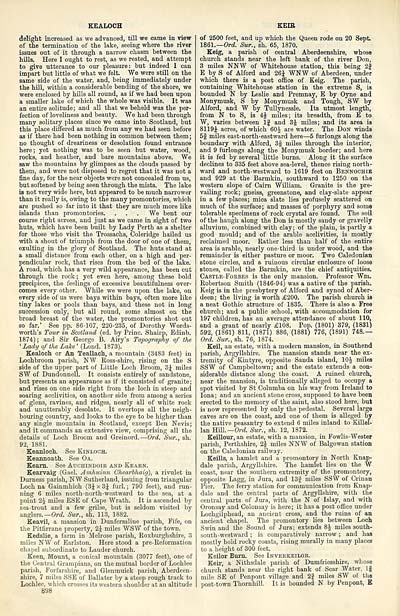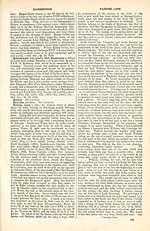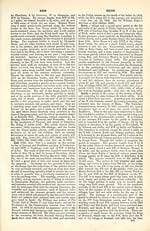Ordnance gazetteer of Scotland
(906) Page 898
Download files
Complete book:
Individual page:
Thumbnail gallery: Grid view | List view

KEALOCH
delight increased as we advanced, till we came in view
of the termination of the lake, seeing where the river
issues out of it through a narrow chasm between the
hills. Here I ought to rest, as we rested, and attempt
to give utterance to our pleasure: but indeed I can
impart but little of what we felt. "We were still on the
same side of the water, and, being immediately under
the hill, within a considerable bending of the shore, we
were enclosed by hills all round, as if we had been upon
a smaller lake of which the whole was visible. It was
an entire solitude; and all that we beheld was the per-
fection of loveliness and beauty. We had been through
many solitary places since we came into Scotland, but
this place differed as much from any we had seen before
as if there had been nothing in common between them;
no thought of dreariness or desolation found entrance
here ; yet nothing was to be seen but water, wood,
rocks, and heather, and bare mountains above. "We
saw the mountains by glimpses as the clouds passed by
them, and were not disposed to regret that it was not a
fine day, for the near objects were not concealed from us,
but softened by being seen through the mists. The lake
is not very wide here, but appeared to be much narrower
than it really is, owing to the many promontories, which
are pushed so far into it that they are much more like
islands than promontories. . . . We bent our
course right across, and just as we came in sight of two
huts, which have been built by Lady Perth as a shelter
for those who visit the Trossachs, Coleridge hailed us
with a shout of triumph from the door of one of them,
exulting in the glory of Scotland. The huts stand at
a small distance from each other, on a high and per-
pendicular rock, that rises from the bed of the lake.
A road, which has a very wild appearance, has been cut
through the rock ; yet even here, among these bold
precipices, the feelings of excessive beautifulness over-
comes every other. While we were upon the lake, on
every side of us were bays within bays, often more like
tiny lakes or pools than bays, and these not in long
succession only, but all round, some almost on the
broad breast of the water, the promontories shot out
so far.' See pp. 86-107, 220-235, of Dorothy Words-
worth's Tour in Scotland (ed. by Princ. Shairp, Edinb.
1874) ; and Sir George B. Airy's Topography of the
' Lady of the Lake ' (Lond. 1873).
Kealoch or An Teallach, a mountain (3483 feet) in
Lochbroom parish, NW Ross-shire, rising on the S
side of the upper part of Little Loch Broom, 3J miles
SW of Dundonnell. It consists entirely of sandstone,
but presents an appearance as if it consisted of granite ;
and rises on one side right from the loch in steep and
soaring acclivities, on another side from among a series
of glens, ravines, and ridges, nearly all of white rock
and unutterably desolate. It overtops all the neigh-
bouring country, and looks to the eye to be higher than
any single mountain in Scotland, except Ben Nevis;
and it commands an extensive view, comprising all the
details of Loch Broom and Greinord. — Ord. Sur., sh.
92, 1881.
Keanloch. See Kinlooh.
Keannoath. See Oa.
Kearn. See Auchindoir and Kearn.
Kearvaig (Gael. Amhuinn Chearbhaig), a rivulet in
Durness parish, NW Sutherland, issuing from triangular
Loch na Gainmhich (3J x 3J furl. ; 790 feet), and run-
ning 6 miles north-north-westward to the sea, at a
point %\ miles ESE of Cape Wrath. It is ascended by
sea-trout and a few grilse, but is seldom visited by
anglers.— Ord. Sur., sh. 113, 1882.
Keavil, a mansion in Dunfermline parish, Fife, on
the Pitfirrane property, 2£ miles WSW of the town.
Kedslie, a farm in Melrose parish, Roxburghshire, 3
miles NW of Earlston. Here stood a pre- Reformation
chapel subordinate to Lauder church.
Keen, Mount, a conical mountain (3077 feet), one of
the Central Grampians, on the mutual border of Lochlee
parish, Forfarshire, and Glenmuick parish, Aberdeen-
shire, 7 miles SSE of Ballater by a steep rough track to
Lochlee, which crosses its western shoulder at an altitude
898
EEIR
of 2500 feet, and up which the Queen rode on 20 Sept.
1861.— On2. Sur., sh. 65, 1870.
Keig, a parish of central Aberdeenshire, whose
church stands near the left bank of the river Don,
3 miles NNW of Whitehouse station, this being 2|
E by S of Alford and 26J WNW of Aberdeen, under
which there is a post office of Keig. The parish,
containing Whitehouse station in the extreme S, i3
bounded N by Leslie and Premnay, E by Oyne and
Monymusk, S by Monymusk and Tough, SW by
Alford, and W by Tullynessle. Its utmost length,
from N to S, is 4| miles; its breadth, from E to
W, varies between If and 3 J miles; and its area is
8119J acres, of which 60J are water. The Don winds
5f miles east-north-eastward here — 5 furlongs along the
boundary with Alford, 3| miles through the interior,
and 9 furlongs along the Monymusk border; and here
it is fed by several little burns. Along it the surface
declines to 335 feet above sea-level, thence rising north-
ward and north-westward to 1619 feet on Bennochie
and 929 at the Barmkin, southward to 1250 on the
western slope of Cairn William. Granite is the pre-
vailing rock; gneiss, greenstone, and clay -slate appear
in a few places; mica slate lies profusely scattered on
much of the surface; and masses of porphyry and some
tolerable specimens of rock crystal are found. The soil
of the haugh along the Don is mostly sandy or gravelly
alluvium, combined with clay ; of the plain, is partly a
good mould; and of the arable acclivities, is mostly
reclaimed moor. Rather less than half of the entire
area is arable, nearly one-third is under wood, and the
remainder is either pasture or moor. Two Caledonian
stone circles, and a ruinous circular enclosure of loose
Btones, called the Barmkin, are the chief antiquities.
Castle-Forbes is the only mansion. Professor Wni.
Robertson Smith (1846-94) was a native of the parish.
Keig is in the presbytery of Alford and synod of Aber-
deen; the living is worth £200. The parish church is
a neat Gothic structure of 1835. There is also a Free
church; and a public school, with accommodation for
197 children, has an average attendance of about 110,
and a grant of nearly £108. Pop. (1801) 379, (1831)
592, (1861) 811, (1871) 886, (1881) 776, (1891) 748.—
Ord. Sur., sh. 76, 1874.
Eeil, an estate, with a modern mansion, in Southend
parish, Argyllshire. The mansion stands near the ex-
tremity of Kintyre, opposite Sanda island, 10£ miles
SSW of Campbeltown; and the estate extends a con-
siderable distance along the coast. A ruined church,
near the mansion, is traditionally alleged to occupy a
spot visited by St Columba on his way from Ireland to
Iona ; and an ancient stone cross, supposed to have been
erected to the memory of the saint, also stood here, but
is now represented by only the pedestal. Several large
caves are on the coast, and one of them is alleged by
the native peasantry to extend 6 miles inland to Killel-
lan Hill.— Ord. Sur., sh. 12, 1872.
Keillour, an estate, with a mansion, in Fowlis-Wester
parish, Perthshire, 2J miles NNW of Balgowan station
on the Caledonian railway.
Keills, a hamlet and a promontory in North Knap-
dale parish, Argyllshire. The hamlet lies on the W
coast, near the southern extremity of the promontory,
opposite Lagg, in Jura, and 13| miles SSW of Crinan
Pier. The ferry station for communication from Knap-
dale and the central parts of Argyllshire, with the
central parts of Jura, with the N of Islay, and with
Oronsay and Colonsay is here; it has a post office under
Lochgilphead, an ancient cross, and the ruins of an
ancient chapel. The promontory lies between Loch
Swin and the Sound of Jura; extends 8£ miles south-
south-westward ; is comparatively narrow ; and has
mostly bold rocky coasts, rising murally in many places
to a height of 300 feet.
Keilor Burn. See Inverkeilor.
Keir, a Nithsdale parish of Dumfriesshire, whose
church stands near the right bank of Scar Water, 1§
mile SE of Penpont village and 2| miles SW of the
post-town Thornhill. It is bounded N by Penpont, E
delight increased as we advanced, till we came in view
of the termination of the lake, seeing where the river
issues out of it through a narrow chasm between the
hills. Here I ought to rest, as we rested, and attempt
to give utterance to our pleasure: but indeed I can
impart but little of what we felt. "We were still on the
same side of the water, and, being immediately under
the hill, within a considerable bending of the shore, we
were enclosed by hills all round, as if we had been upon
a smaller lake of which the whole was visible. It was
an entire solitude; and all that we beheld was the per-
fection of loveliness and beauty. We had been through
many solitary places since we came into Scotland, but
this place differed as much from any we had seen before
as if there had been nothing in common between them;
no thought of dreariness or desolation found entrance
here ; yet nothing was to be seen but water, wood,
rocks, and heather, and bare mountains above. "We
saw the mountains by glimpses as the clouds passed by
them, and were not disposed to regret that it was not a
fine day, for the near objects were not concealed from us,
but softened by being seen through the mists. The lake
is not very wide here, but appeared to be much narrower
than it really is, owing to the many promontories, which
are pushed so far into it that they are much more like
islands than promontories. . . . We bent our
course right across, and just as we came in sight of two
huts, which have been built by Lady Perth as a shelter
for those who visit the Trossachs, Coleridge hailed us
with a shout of triumph from the door of one of them,
exulting in the glory of Scotland. The huts stand at
a small distance from each other, on a high and per-
pendicular rock, that rises from the bed of the lake.
A road, which has a very wild appearance, has been cut
through the rock ; yet even here, among these bold
precipices, the feelings of excessive beautifulness over-
comes every other. While we were upon the lake, on
every side of us were bays within bays, often more like
tiny lakes or pools than bays, and these not in long
succession only, but all round, some almost on the
broad breast of the water, the promontories shot out
so far.' See pp. 86-107, 220-235, of Dorothy Words-
worth's Tour in Scotland (ed. by Princ. Shairp, Edinb.
1874) ; and Sir George B. Airy's Topography of the
' Lady of the Lake ' (Lond. 1873).
Kealoch or An Teallach, a mountain (3483 feet) in
Lochbroom parish, NW Ross-shire, rising on the S
side of the upper part of Little Loch Broom, 3J miles
SW of Dundonnell. It consists entirely of sandstone,
but presents an appearance as if it consisted of granite ;
and rises on one side right from the loch in steep and
soaring acclivities, on another side from among a series
of glens, ravines, and ridges, nearly all of white rock
and unutterably desolate. It overtops all the neigh-
bouring country, and looks to the eye to be higher than
any single mountain in Scotland, except Ben Nevis;
and it commands an extensive view, comprising all the
details of Loch Broom and Greinord. — Ord. Sur., sh.
92, 1881.
Keanloch. See Kinlooh.
Keannoath. See Oa.
Kearn. See Auchindoir and Kearn.
Kearvaig (Gael. Amhuinn Chearbhaig), a rivulet in
Durness parish, NW Sutherland, issuing from triangular
Loch na Gainmhich (3J x 3J furl. ; 790 feet), and run-
ning 6 miles north-north-westward to the sea, at a
point %\ miles ESE of Cape Wrath. It is ascended by
sea-trout and a few grilse, but is seldom visited by
anglers.— Ord. Sur., sh. 113, 1882.
Keavil, a mansion in Dunfermline parish, Fife, on
the Pitfirrane property, 2£ miles WSW of the town.
Kedslie, a farm in Melrose parish, Roxburghshire, 3
miles NW of Earlston. Here stood a pre- Reformation
chapel subordinate to Lauder church.
Keen, Mount, a conical mountain (3077 feet), one of
the Central Grampians, on the mutual border of Lochlee
parish, Forfarshire, and Glenmuick parish, Aberdeen-
shire, 7 miles SSE of Ballater by a steep rough track to
Lochlee, which crosses its western shoulder at an altitude
898
EEIR
of 2500 feet, and up which the Queen rode on 20 Sept.
1861.— On2. Sur., sh. 65, 1870.
Keig, a parish of central Aberdeenshire, whose
church stands near the left bank of the river Don,
3 miles NNW of Whitehouse station, this being 2|
E by S of Alford and 26J WNW of Aberdeen, under
which there is a post office of Keig. The parish,
containing Whitehouse station in the extreme S, i3
bounded N by Leslie and Premnay, E by Oyne and
Monymusk, S by Monymusk and Tough, SW by
Alford, and W by Tullynessle. Its utmost length,
from N to S, is 4| miles; its breadth, from E to
W, varies between If and 3 J miles; and its area is
8119J acres, of which 60J are water. The Don winds
5f miles east-north-eastward here — 5 furlongs along the
boundary with Alford, 3| miles through the interior,
and 9 furlongs along the Monymusk border; and here
it is fed by several little burns. Along it the surface
declines to 335 feet above sea-level, thence rising north-
ward and north-westward to 1619 feet on Bennochie
and 929 at the Barmkin, southward to 1250 on the
western slope of Cairn William. Granite is the pre-
vailing rock; gneiss, greenstone, and clay -slate appear
in a few places; mica slate lies profusely scattered on
much of the surface; and masses of porphyry and some
tolerable specimens of rock crystal are found. The soil
of the haugh along the Don is mostly sandy or gravelly
alluvium, combined with clay ; of the plain, is partly a
good mould; and of the arable acclivities, is mostly
reclaimed moor. Rather less than half of the entire
area is arable, nearly one-third is under wood, and the
remainder is either pasture or moor. Two Caledonian
stone circles, and a ruinous circular enclosure of loose
Btones, called the Barmkin, are the chief antiquities.
Castle-Forbes is the only mansion. Professor Wni.
Robertson Smith (1846-94) was a native of the parish.
Keig is in the presbytery of Alford and synod of Aber-
deen; the living is worth £200. The parish church is
a neat Gothic structure of 1835. There is also a Free
church; and a public school, with accommodation for
197 children, has an average attendance of about 110,
and a grant of nearly £108. Pop. (1801) 379, (1831)
592, (1861) 811, (1871) 886, (1881) 776, (1891) 748.—
Ord. Sur., sh. 76, 1874.
Eeil, an estate, with a modern mansion, in Southend
parish, Argyllshire. The mansion stands near the ex-
tremity of Kintyre, opposite Sanda island, 10£ miles
SSW of Campbeltown; and the estate extends a con-
siderable distance along the coast. A ruined church,
near the mansion, is traditionally alleged to occupy a
spot visited by St Columba on his way from Ireland to
Iona ; and an ancient stone cross, supposed to have been
erected to the memory of the saint, also stood here, but
is now represented by only the pedestal. Several large
caves are on the coast, and one of them is alleged by
the native peasantry to extend 6 miles inland to Killel-
lan Hill.— Ord. Sur., sh. 12, 1872.
Keillour, an estate, with a mansion, in Fowlis-Wester
parish, Perthshire, 2J miles NNW of Balgowan station
on the Caledonian railway.
Keills, a hamlet and a promontory in North Knap-
dale parish, Argyllshire. The hamlet lies on the W
coast, near the southern extremity of the promontory,
opposite Lagg, in Jura, and 13| miles SSW of Crinan
Pier. The ferry station for communication from Knap-
dale and the central parts of Argyllshire, with the
central parts of Jura, with the N of Islay, and with
Oronsay and Colonsay is here; it has a post office under
Lochgilphead, an ancient cross, and the ruins of an
ancient chapel. The promontory lies between Loch
Swin and the Sound of Jura; extends 8£ miles south-
south-westward ; is comparatively narrow ; and has
mostly bold rocky coasts, rising murally in many places
to a height of 300 feet.
Keilor Burn. See Inverkeilor.
Keir, a Nithsdale parish of Dumfriesshire, whose
church stands near the right bank of Scar Water, 1§
mile SE of Penpont village and 2| miles SW of the
post-town Thornhill. It is bounded N by Penpont, E
Set display mode to: Large image | Transcription
Images and transcriptions on this page, including medium image downloads, may be used under the Creative Commons Attribution 4.0 International Licence unless otherwise stated. ![]()
| Gazetteers of Scotland, 1803-1901 > Ordnance gazetteer of Scotland > (906) Page 898 |
|---|
| Permanent URL | https://digital.nls.uk/97404118 |
|---|

